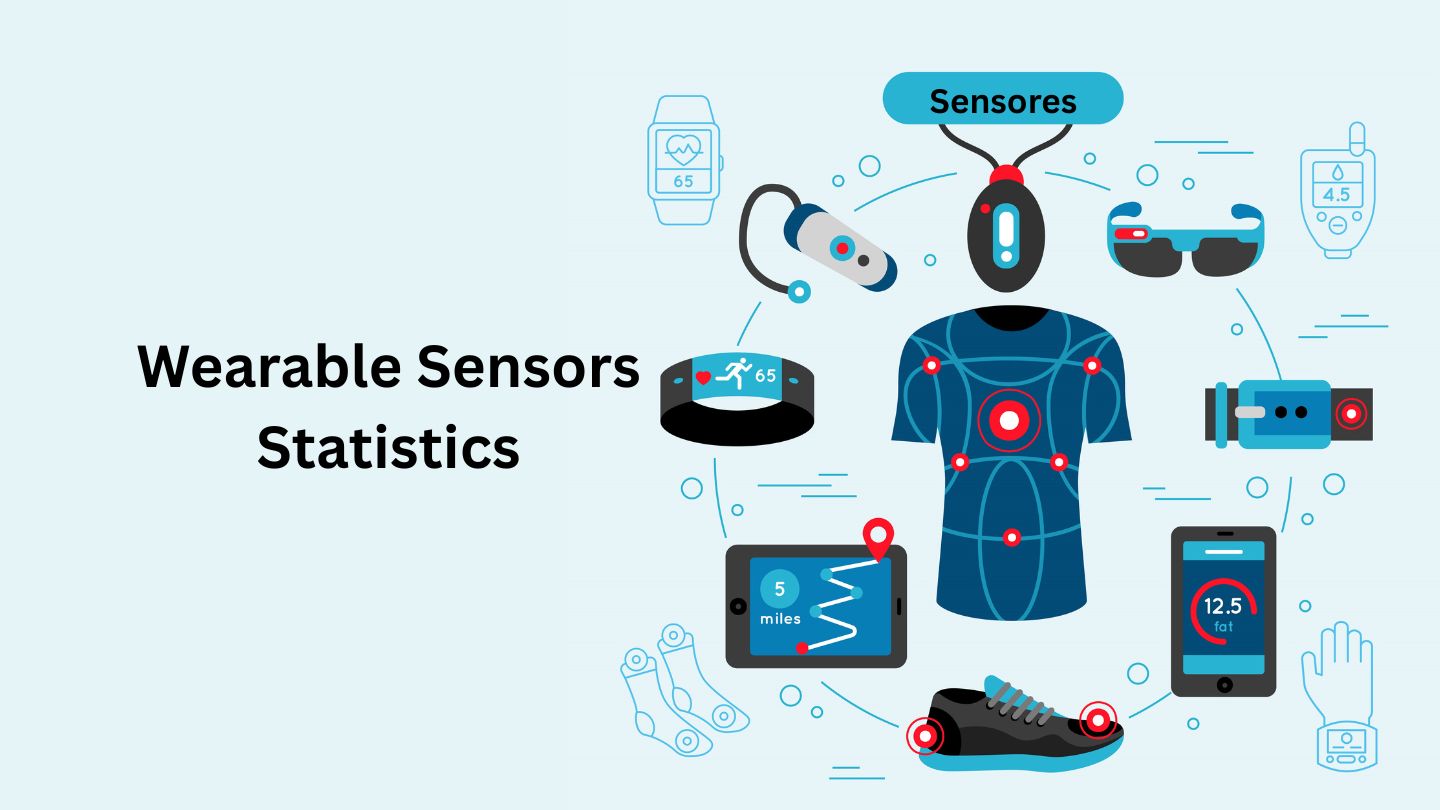Smart Bandage Statistics and Facts (2025)

Updated · Mar 05, 2025


TABLE OF CONTENTS
Introduction
Smart Bandage Statistics: Increasing awareness of wound care, the benefits of smart bandages compared to regular ones, and the rising cases of chronic illnesses are driving the demand for smart bandages. The market is growing as these advanced bandages help manage wound healing more effectively.
These factors are expected to support the expansion of the smart bandages market in the coming years. Moreover, smart bandages can send wound data wirelessly to a nearby computer, tablet, or smartphone, allowing doctors to review it. This technology is expected to strengthen the smart bandage industry outlook during the forecast period. This article will shed more light on Smart Bandage Statistics.
Editor’s Choice
- The Wound Care Market is expected to grow from $18.4 billion in 2022 to about $30.2 billion by 2032, with an average annual growth rate (CAGR) of 2% between 2022 and 2032.
- In 2022, the worldwide smart bandages market was valued at $1.5 billion.
- With advancements in technology and rising demand for better wound care solutions, the market is predicted to reach $2.9 billion by 2027, expanding at a CAGR of 14.1%.
- In 2022, North America held the largest share of the global smart bandages market, accounting for 43% of total sales.
- Leading companies in the smart bandages industry include 3M, Medtronic, Smith & Nephew, and others.
- Smart bandages are in high demand for treating chronic wounds and post-surgery recovery.
- Smart Bandage Statistics stated that the COVID-19 pandemic has greatly impacted the healthcare industry, speeding up the use of telemedicine and remote patient monitoring, including smart bandages.
- Electroactive smart bandages are highly popular, with about 25% of users choosing them.
- Around 20% of users prefer sensor-based smart bandages for wound care.
- Meanwhile, drug-infused, oxygen-detecting, and pH-monitoring smart bandages are each selected by 15% of users.
Smart Bandage Engineering Marvel
The electronic layer of the smart bandage, which includes a microcontroller (MCU), radio antenna, memory, electrical stimulator, biosensors, and other small parts, is extremely thin—only 100 microns, about as thick as a single coat of latex paint.
This technology is built on a specially designed hydrogel. This soft, skin-like material helps with healing by delivering electrical stimulation while also collecting real-time sensor data from the wound.
 (Source: stanford.edu)
(Source: stanford.edu)
Using electrical stimulation (also called galvanotaxis) has been shown to speed up skin cell movement (keratinocytes) to the wound, reduce bacterial infections, and prevent biofilm formation, which supports tissue growth and repair. Researchers have combined this proven technique with real-time sensor data to develop an advanced, automated treatment that adjusts based on the wound’s condition.
The hydrogel material is specially designed to stick firmly to the wound when needed. Still, it can be removed easily without causing damage when gently heated to about 40°C (104°F), just slightly warmer than normal body temperature.
The biosensors in a smart bandage monitor physical changes in the wound area, providing a quick, dependable, and highly precise way to track healing in real-time.
From a technical standpoint, the smart bandage measures shifts in the skin’s conductivity and temperature. As the wound improves, electrical resistance increases, while local temperature decreases as the swelling goes down.
General Smart Bandage Statistics
- The global smart bandages market earned $0.81 billion in 2023 and is expected to grow to $2.90 billion by 2033, with an annual growth rate (CAGR) of 13.6%.
- Smart Bandage Statistics stated that Electroactive smart bandages were the top-selling product in 2023, holding the largest market share of 26.8%.
- The market is divided into graphene, synthetic fiber, and other materials. Graphene-based smart bandages led the market, making up 47.1% of total revenue in 2023.
- For chronic wounds, burns, sports injuries, post-surgical recovery, and other medical conditions. Chronic wound care was the largest segment in 2023, contributing 29.7% of the revenue.
- Smart bandages are sold through retail pharmacies, hospital pharmacies, trauma centers, and other outlets. Hospital pharmacies generated the largest share, 39.5% of total sales.
- North America dominated the smart bandages market in 2023, with a 42.8% share. This region is expected to stay in the lead throughout the forecast period.
- The worldwide smart bandages industry is predicted to increase at a compound annual growth rate (CAGR) of 14.5% from 2024 to 2034.
- By 2034, the market is projected to reach a total value of $3.12 billion.
- In the United States, the market is estimated to be worth $301.2 million in 2024.
- Smart Bandage Statistics stated that India is expected to hold a 53.4% share of the South Asia & Pacific market in 2024.
- Revenue from long-term care facilities is predicted to grow to $817.1 million by 2034.
- The East Asia market is expected to expand at a CAGR of 15.8% between 2024 and 2034.
Smart Bandage Market Growth Statistics
- The National Institute of Health (NIH) estimates that by 2030, the global diabetes rate will reach 10.2%, affecting 578 million people.
- People with diabetes have a 25% chance of developing diabetic foot ulcers (DFUs) at some point in their lives.
- Smart bandages, also known as modern dressings, help patients heal more comfortably and conveniently while also reducing hospital stays. These advanced medical dressings create the perfect environment for complex wounds to heal faster and more safely.
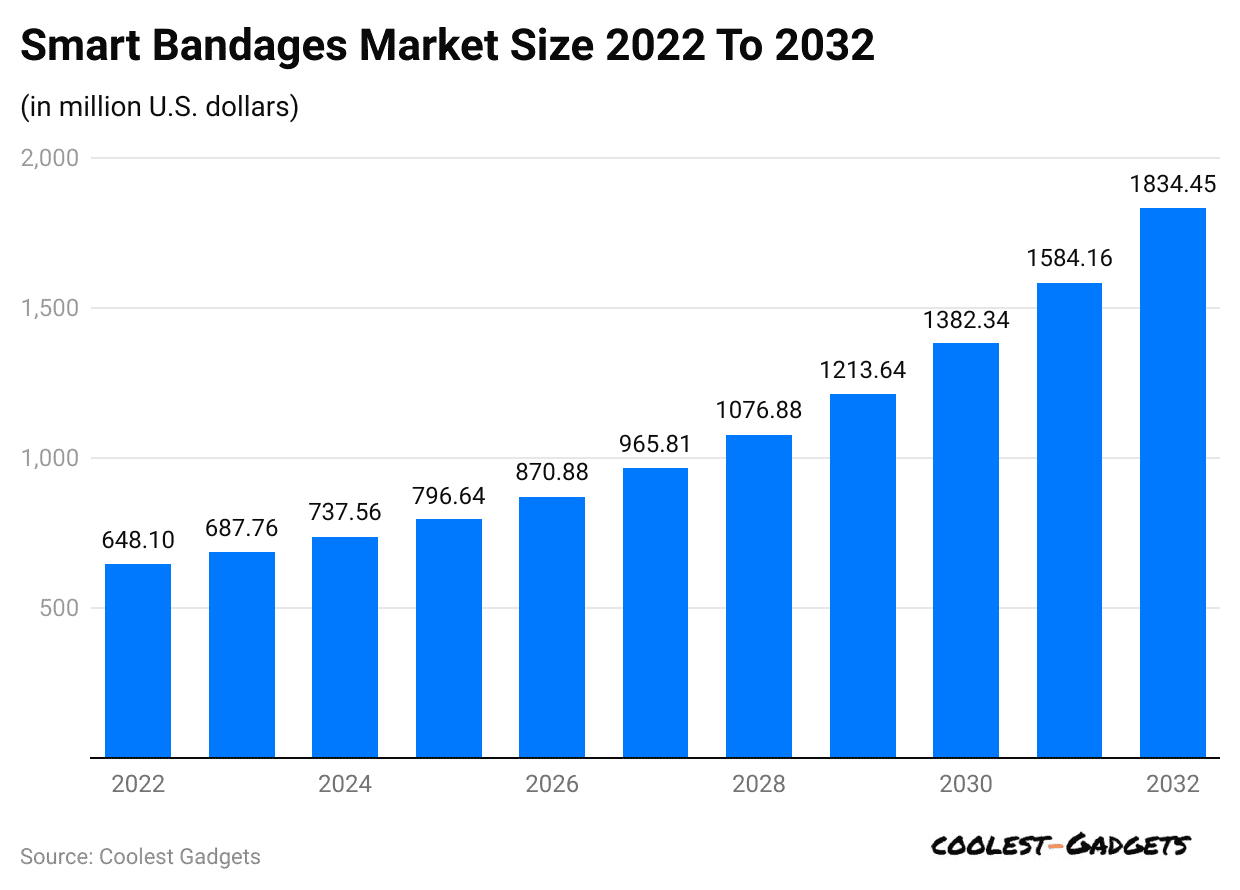 (Reference: globenewswire.com)
(Reference: globenewswire.com)
- With improvements in technology, different types of wound dressings have been designed to support various stages of healing and treat different types of wounds.
- The approach to wound treatment is shifting away from invasive surgical debridement toward non-surgical methods, thanks to the development of advanced debridement technologies that offer significant medical benefits.
- Normally, when someone gets a burn, cut, or scrape, their body heals quickly. However, this isn’t always the case.
- Smart Bandage Statistics stated that diabetes can slow down wound healing, leading to chronic wounds that may become infected or worsen.
- These long-lasting wounds not only affect patients’ health but also put a $25 billion annual strain on the U.S. healthcare system.
Types of Smart Bandages and Their Benefits
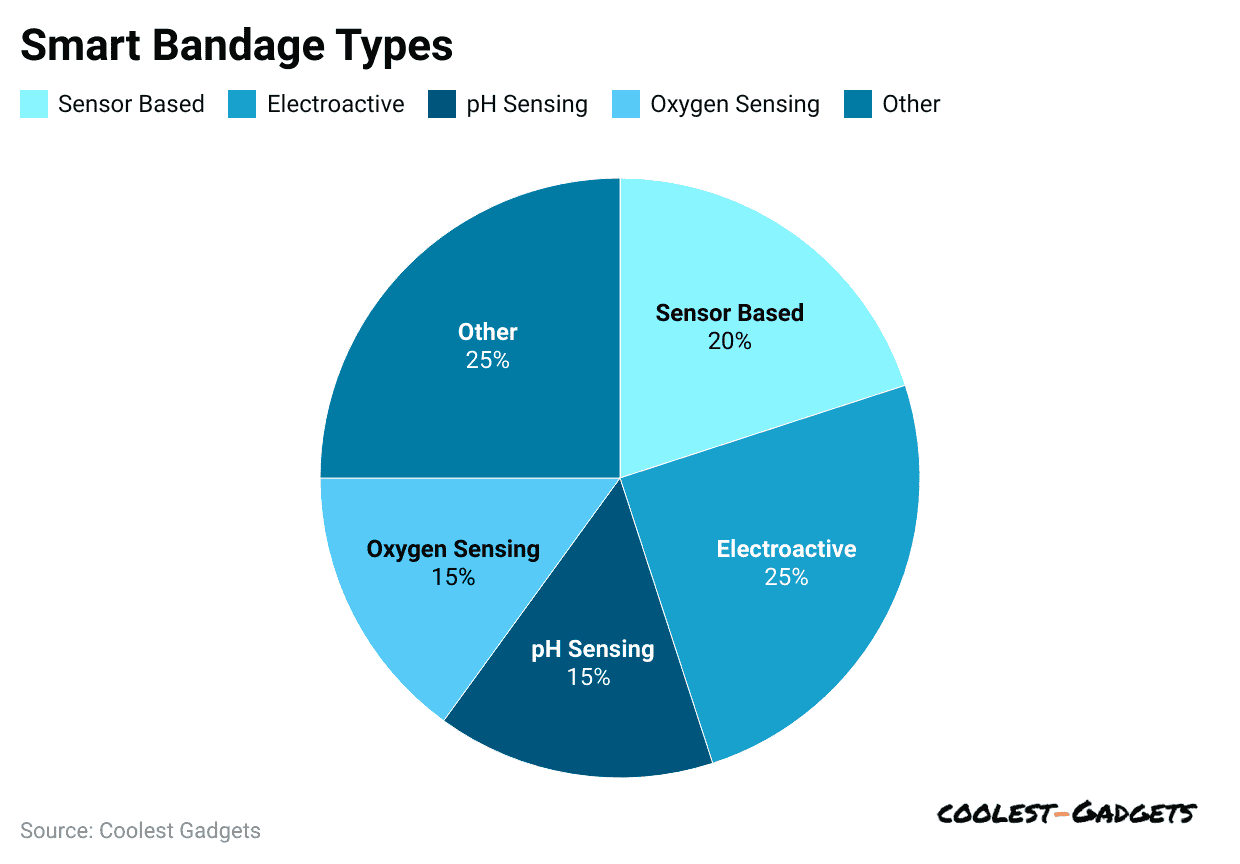 (Source: finance.yahoo.com)
(Source: finance.yahoo.com)
- Sensor-Based Smart Bandages: These bandages have built-in sensors that track important factors at the wound site, such as temperature, moisture, pH levels, and pressure. They provide doctors with real-time updates, allowing them to monitor healing progress closely.
- Drug-Infused Smart Bandages: Designed to deliver medicine directly to the wound, these bandages release medication at specific intervals over time. They are especially useful for chronic wounds or infections that require targeted treatment.
- Electroactive Smart Bandages: These bandages use mild electrical stimulation to speed up healing. The low-level electrical currents help improve tissue growth and blood circulation, allowing wounds to heal faster.
- Temperature-Sensitive Smart Bandages: Made with heat-sensitive materials, these bandages change colour based on the wound’s temperature. This helps healthcare providers quickly detect infections or inflammation just by looking at the bandage.
- pH-Sensing Smart Bandages: These bandages track pH levels at the wound site. Since pH changes can indicate infections or delayed healing, they help doctors identify problems early and adjust treatment accordingly.
- Oxygen-Sensing Smart Bandages: These bandages have built-in oxygen sensors to measure oxygen levels at the wound site. They are especially helpful for chronic wounds or post-surgery wounds, where proper oxygen supply is essential for healing.
Smart Bandage Users by Demographics
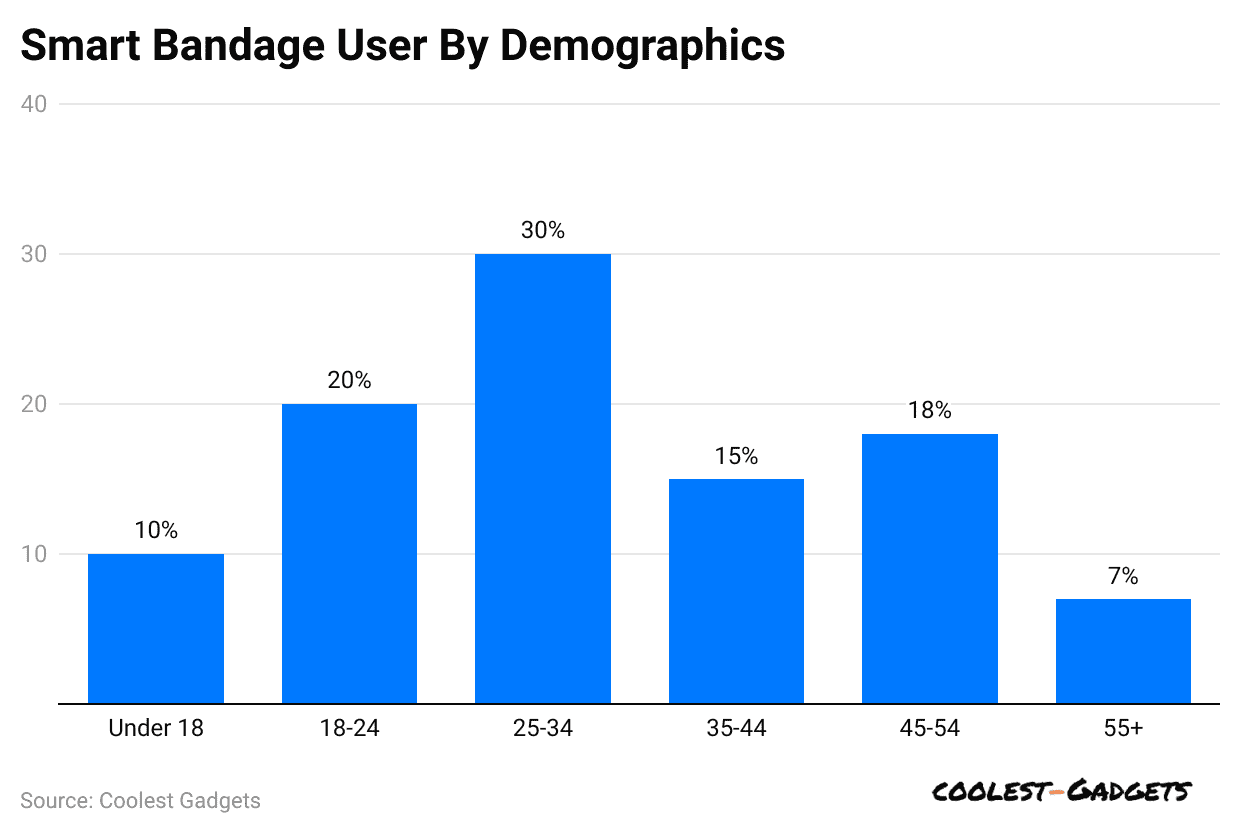 (Reference: finance.yahoo.com)
(Reference: finance.yahoo.com)
- People between the ages of 25-34 are the biggest users of smart bandages, accounting for 30% of total users.
- Smart Bandage Statistics stated that around 20% of individuals aged 18-24 use smart bandages for wound care and monitoring chronic wounds.
- About 18% of users aged 45-54 prefer smart bandages, followed by 15% of those aged 35-44.
- Usage is lower among people 55 and older (7%) and those under 18 (10%).
Smart Bandage Market Size By Market.us
(Source: market.us)
- The Global Smart Bandages Market size is expected to be worth around USD 2.90 billion by 2033, growing from USD 0.81 billion in 2023, with a CAGR of 13.6% from 2024 to 2033.
- According to research published in Polymers magazine, around 20 million individuals worldwide suffer from chronic wounds.
- A study in Trends in Biotechnology states that the market value of products used for wound healing exceeds USD 15 billion, while the market for skin scar prevention amounts to USD 12 billion.
- Electroactive smart bandages held the largest market share of 26.8% in 2023, making them the leading contributor to market revenue.
- The market is categorized by material into graphene, synthetic fiber, and other materials, with graphene capturing the highest revenue share of 47.1% in 2023.
- In terms of applications, chronic wound management was the dominant segment in 2023, holding a revenue share of 29.7%.
- The primary distribution channels for smart bandages include retail pharmacies, hospital pharmacies, trauma centers, and other medical outlets. Hospital pharmacies led with a revenue share of 39.5% in 2023.
- North America maintained its leadership position in the global smart bandages market in 2023, with a market share of 42.8%, and is expected to continue its dominance throughout the forecast period.
By Product Type
The smart bandages market is categorized into electroactive, sensor-based, Oxygen-sensitive, pH-sensitive, and other types.
- Electroactive smart bandages held the largest market share (27.8%) in 2023.
- They are highly preferred because they use electrical stimulation to speed up wound healing.
- Additionally, they offer real-time tracking and controlled drug release, making them a top choice.
- Smart Bandage Statistics stated that Sensor-based smart bandages are expected to grow the fastest in the coming years.
- This growth is fueled by the increasing need for precise wound care and the integration of real-time monitoring technology.
By Application
Smart bandages are widely used for chronic wound treatment, burns, sports injuries, post-surgical recovery, and other medical needs.
- Chronic wound care was the top application segment in 2023, making up 29.7% of the total revenue.
- Smart Bandage Statistics stated that the growing number of chronic wounds, injuries, and accidents worldwide is driving demand for advanced wound care products.
- The sports injury segment is expected to grow the fastest due to an increase in sports-related injuries and rising awareness of modern medical treatments for quicker recovery.
By Material Type
The market is divided into graphene, synthetic fiber, and other materials.
- Graphene-based smart bandages led the market in 2023, holding a 47.1% market share.
- Graphene is lightweight, flexible, and extremely strong—200 times stronger than steel, according to the American Chemical Society—making it perfect for advanced medical applications.
- Synthetic fiber smart bandages are expected to experience the highest growth rate due to their affordability, durability, and lightweight properties, making them a popular alternative.
By Distribution Channel
Smart bandages are sold through hospital pharmacies, retail pharmacies, trauma centers, and other sales channels.
- Smart Bandage Statistics stated that hospital pharmacies were the largest revenue generator in 2023, accounting for 39.5% of total sales.
- Their wide range of products, advanced medical equipment, and experienced healthcare professionals make them the go-to option for patients and doctors.
- Retail pharmacies are projected to experience the fastest growth as they become more accessible in both urban and rural areas, making advanced wound care products easier for the general public to purchase.
Challenges in Smart Bandage Statistics
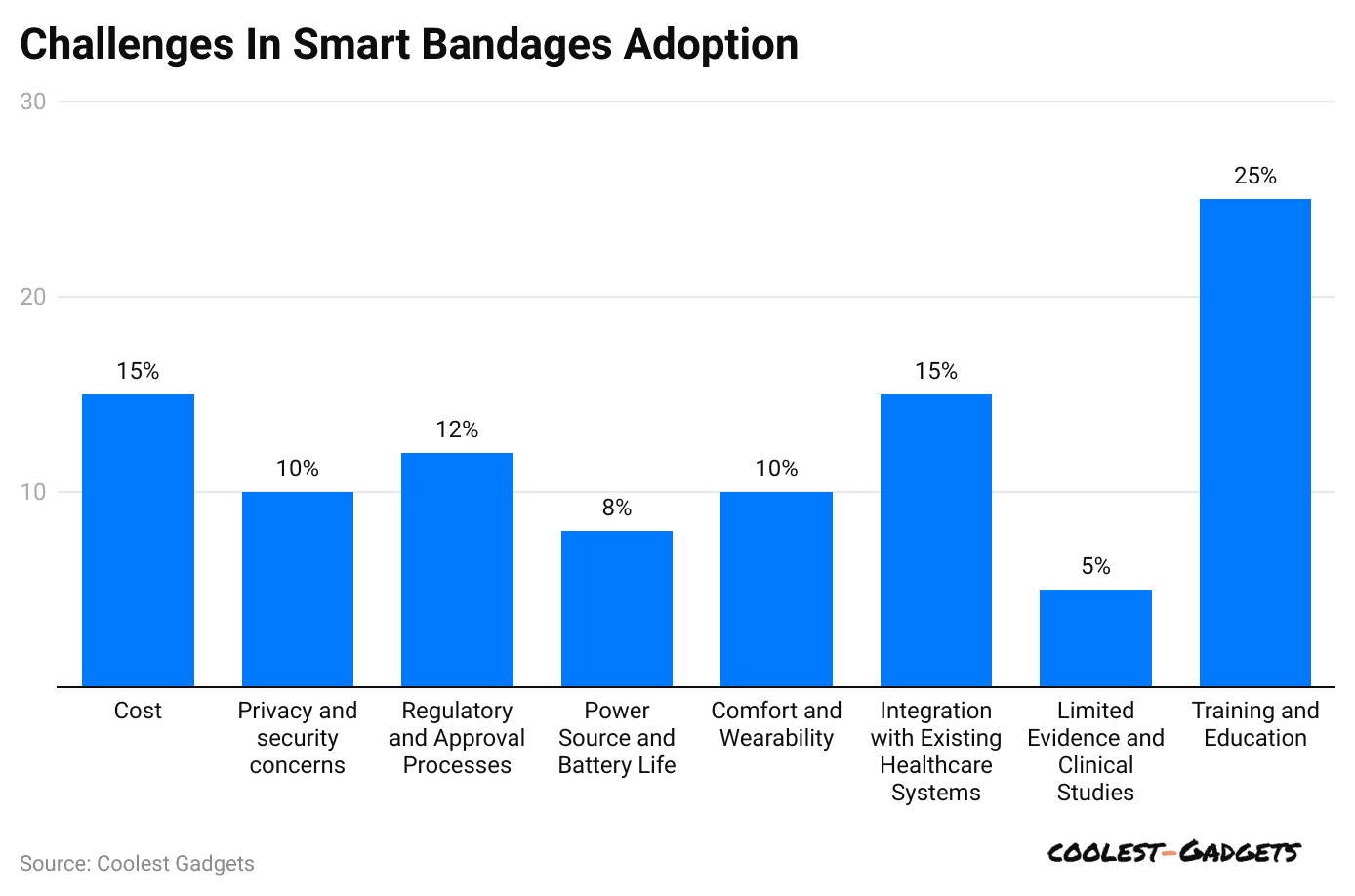 (Reference: finance.yahoo.com)
(Reference: finance.yahoo.com)
- High Cost: Smart bandages use special materials, built-in sensors, and wireless technology, which makes them more expensive than regular bandages. The high price could make them harder to afford, especially in hospitals and clinics with limited budgets. If these bandages are too costly, fewer people will be able to use them unless insurance plans or government programs help cover the expenses.
- Regulatory Approval Challenges: Since smart bandages are medical devices, they must pass strict safety and quality tests before they can be used in hospitals or sold to the public. Getting approval from health authorities can take a long time and cost a lot of money, which might slow down how quickly these bandages become widely available. Different countries also have different rules, making the approval process even more complicated.
- Compatibility with Healthcare Systems: Smart bandages collect important health data, but they must work smoothly with existing hospital software, like electronic health records (EHRs). If these systems can’t easily share and use the data, the bandages won’t be as useful. Since hospitals use different types of software, making sure smart bandages can connect with all of them is a big challenge.
- Privacy and Security Risks: Smart bandages track personal health details, such as how well a wound is healing and a patient’s vital signs. Since this data is sent wirelessly, there is a risk of hackers stealing or misusing it. Strong security features like encrypted data, safe networks, and strict privacy rules (such as HIPAA in the U.S. or GDPR in Europe) are needed to protect patients’ information. Any security failure could lead to serious trust issues and legal problems.
- Need for Training and Education: Doctors, nurses, and other healthcare workers must learn how to use smart bandages properly and understand the data they provide. If they don’t know how to interpret the information, the technology won’t be as effective. Training programs will be necessary to make sure healthcare providers can use these bandages correctly and make informed medical decisions.
Conclusion
In summary, smart bandages can change the way wounds are treated by providing real-time information, speeding up healing, and reducing hospital visits. However, statistics show that their use is still low because of high prices, strict approval processes, and difficulties in connecting with hospital systems. Concerns about data privacy and the need for proper training also slow down their adoption. Even with these challenges, improvements in technology and more funding in digital healthcare are expected to boost the smart bandage market.
As prices drop and regulations become clearer, smart bandages could become a common medical tool, helping patients worldwide. We have shed enough light on Smart Bandage Statistics through this article.
Sources
FAQ.
More than 200 million bandage products are bought in the U.S. every year, showing how essential wound care is in healthcare. As technology improves, smart bandages could take a larger share of this market by providing faster healing and better patient care. Their advanced features may make them a popular choice in the future, despite their higher cost.
Recent breakthroughs in wound care include nanotechnology treatments, stem cell therapy, lab-grown skin grafts, and 3D bioprinting. These advanced methods focus on healing wounds faster by helping the skin regenerate while lowering the risk of side effects. As research continues, these technologies could provide better options for patients with serious or long-lasting wounds.
The worldwide market for medical tapes and bandages is expected to grow from $8.9 billion in 2024 to $12.8 billion by 2033, with a yearly growth rate (CAGR) of 4.2%. This steady rise shows the increasing need for wound care products, including high-tech solutions like smart bandages.

Saisuman is a talented content writer with a keen interest in mobile tech, new gadgets, law, and science. She writes articles for websites and newsletters, conducting thorough research for medical professionals. Fluent in five languages, her love for reading and languages led her to a writing career. With a Master’s in Business Administration focusing on Human Resources, Saisuman has worked in HR and with a French international company. In her free time, she enjoys traveling and singing classical songs. At Coolest Gadgets, Saisuman reviews gadgets and analyzes their statistics, making complex information easy for readers to understand.







